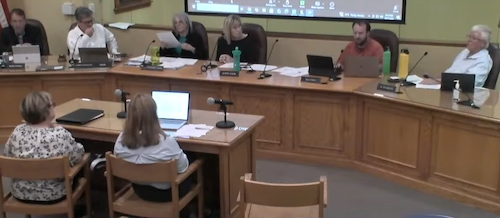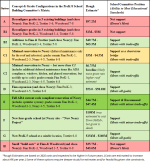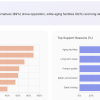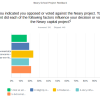Above: The PreK-8SBC made its final report to the Select Board this week. (photo from video)
On Tuesday night, the Select Board heard the final report from the PreK-8 School Building Committee. The committee gave them a lot of data to reflect on when the board decides what next steps to take.
Here’s my high level overview of the picture presented and highlights from the meeting.
The Select Board heard about the data the committee pullled together for a wide range of school building project scenarios. Using cost estimates for 2025 construction, the options ranged from a $6.75M “baseline” for a minimal renovation of Neary to an up to $160M (land price not included) to build a brand new school on a new site that houses all of the elementary grades (PreK-5). (There was also a $1M-$3M option, but that would be just a short-term measure that would require a subsequent project.)
The project costs are estimated to rise by about 4% each year between now and actual construction. And the costs are very rough estimates that would need to be vetted through feasibility studies. (And some options may turn out to not be truly viable due to site constraints.)
The committee spent over an hour walking the board and public through their reports and matrix, and answering questions.
That included a report from Chair Beth Wittcoff and member Kelly Conklin who represented the committee on a subgroup that worked with the school district’s leadership team to evaluate the educational implications of each scenario. They explained the thinking behind their determinations (echoed by the Southborough School Committee) as to why some of the scenarios would fail to meet the district’s current educational standards. For others, they explained what “trade-offs” would be required.
In the meeting, PreK-8 member Howard Anderson highlighted that he believed the report misunderstood option H, which he had suggested.
Anderson said the administration had evaluated the scenario as though it would be the addition of permanent modular units to Woodward and Finn (permanent versions of the mobile units the district intended to use during the two school years when the new Neary was to be built.) What he had intended was permanent “buildouts” at the school.
Conklin said the group discussed that the night prior, and had the same assessment that it wouldn’t support the district’s educational standards.
Another member, Gene Karmalac, questioned the group’s assumptions about the number of classrooms that would be needed for grades K-1 under scenario B1. Superintendent Gregory Martineau explained the updated enrollment forecast used. He noted that whatever scenario they look at needs to include contingencies for enrollment variations.
Click on the image below for the broad strokes of what was presented:
In all of the scenarios that evaluated space at Trottier, the assumption was made that two special needs programs would remain in support of Southborough students: CASTLE (Communication, Access, Socialization, Transition, Learning, and Emotional Regulation) and CALM (a therapeutic program). But two programs that rent space at the school would no longer be housed there — AVC REACH Program (Assabet Valley Collaborative) and NECC (New England Center for Children). And Southborough Access Media would also lose its studio in the building.
For the data behind my above summary, check out the final report, very detailed matrix, and supporting documents compiled by the committee. (You can find those docs in my dedicated post here. And you can watch Tuesday’s discussion here.)
Given the high costs for the scenarios outlined for going it alone without a state grant, Select Board member Kathy Cook asked Wittcoff if she still believed that it was the right decision to not extend the deadline for using the MSBA grant for the proposed Neary Building Project (option F). Witcoff responded that it was.
Select Board members indicated they need time to digest all the data before discussing next steps. Superintendent Gregory Martineau suggested the next step would be for the Select Board and School Committee to convene to discuss “the next iteration of the work that needs to be done”.
As I previously covered, the School Committee voted to endorse the district leadership’s recommendation of option E, a full, ADA Compliant renovation of Neary School. (With inflation predictors, if constructed in 2026 or 2026, the matrix shows the rough cost estimate is $46.5M – $51.2M.)
During the meeting, Martineau explained to the Select Board that his team and the School Committee had shifted their priorities for the project based on the public feedback and data from the community survey. They understood that while the administration had focused on reducing the number of transitions for elementary school students, the community was more concerned about the cost.
Wittcoff called that a “testament” to the great job educators are doing in making the transitions smooth for students.
Select Board member Al Hamilton stressed that he believes an important next step is for the Select Board to figure out how much the Town can afford to actually spend on a project:
I’ve been critical in the past that we have engaged in building processes and never asked what can we actually afford. And so I think we need to take a hard look at what what the tax what tax burden can the can the taxpayers actually support.
Wittcoff agreed and expanded:
We need to look at what is doable, and we need to look at the buildings that we own and have and we’ve invested in.
She was optimistic that the committee’s work wasn’t in vain. She believed they “fully vetted” the education options, and were able to provide data that “gives future committees some real serious options and directions to consider.”
As a parent who had closely followed the committee’s work, public commenter Mary Tinti urged the Select Board and community to focus in on the “really viable options” that had been identified as supporting educational standards.
Most of the scenarios supported by the School Committee include fixing, renovating, or rebuilding Neary School. Those options may face an additional hurdle (beyond costs or education impacts) for getting voters’ support — some vocal residents’ concerns about the landfill uphill from the site.
Neither the report, nor the discussion on Tuesday night, touched on the environmental concerns that some residents voiced last spring. The closest the report came was pointing out that some of the aspects of project scenarios that were beyond the PreK-8SBC’s scope, and would need further assessment:
There could be additional site-related concerns that extend beyond the scope of this progress report. These include septic system capacity and replacement needs, groundwater management, potential environmental and air quality impacts, parking and traffic flow constraints and the costs and logistics of temporary relocation during construction. These items will require professional evaluation and should be incorporated into any next-phase feasibility study.
Leading up to the failed votes last May on the Neary Building Project, the School Committee, administration and prior Neary Building Committee had sought to assure the public the site was safe. But some voters publicly disagreed with officials’ confidence.
A recent analysis report by Mass Technology Committee Chair Matt Probst on the surveys summarized to the Select Board that only “16% of those who opposed cited site environmental concerns as an influential factor”.
However, Probst’s summary actually only counts the percent of respondents that listed the concern as “Extremely Influential” in their decision making. Adding in “Very Influential” the figure goes up to 40%. Plus, another about 23% listed it as “moderately influential. (See graphs below, from Probst’s presentation and my edited image from the district’s full data report.)
Probst’s report pointed to comments by some respondents indicating that they weren’t aware of any environmental testing that had been done. Surmising that lack of knowledge was a big part of why so many respondents listed environmental concerns as an influential factor, he advised, “Ensuring clear communication of any site studies (e.g. soil tests, mitigation plans) could address these fears.”
At the School Committee’s meeting last night, they discussed reaching out to the Select Board to schedule a joint meeting to discuss next steps. They will ask the board to join the committee’s next monthly meeting on Wednesday, November 12th.
Updated (11/18/2025 11:54 am): I fixed my table that accidentally left grade 6 out of Trottier!






In response to Al Hamilton’s recent comments, he seemed to have agreed with me on the need to modernize the Town government, bring more efficiency to government, fight the vested interests. It sounds to me that Al should join with me and some other citizens who also want to see these changes take place. We should ask the town citizens to begin a committee to seek out a private company to run the management of the town.
Some of the large accounting firms that also do consulting work with many municipalities also offer services to manage and modernize town government. There are also companies such as IBTS.org (institute for building ,technology and safety) which help with all the different issues a town government faces.
Feel free to reach out to me for a meeting and we can begin structuring a town article that will help modernize and bring efficiency to the town of Southborough. Like you I can’t imagine who doesn’t want to see our small town operate better and in a more thrifty manner.
Jack Barron